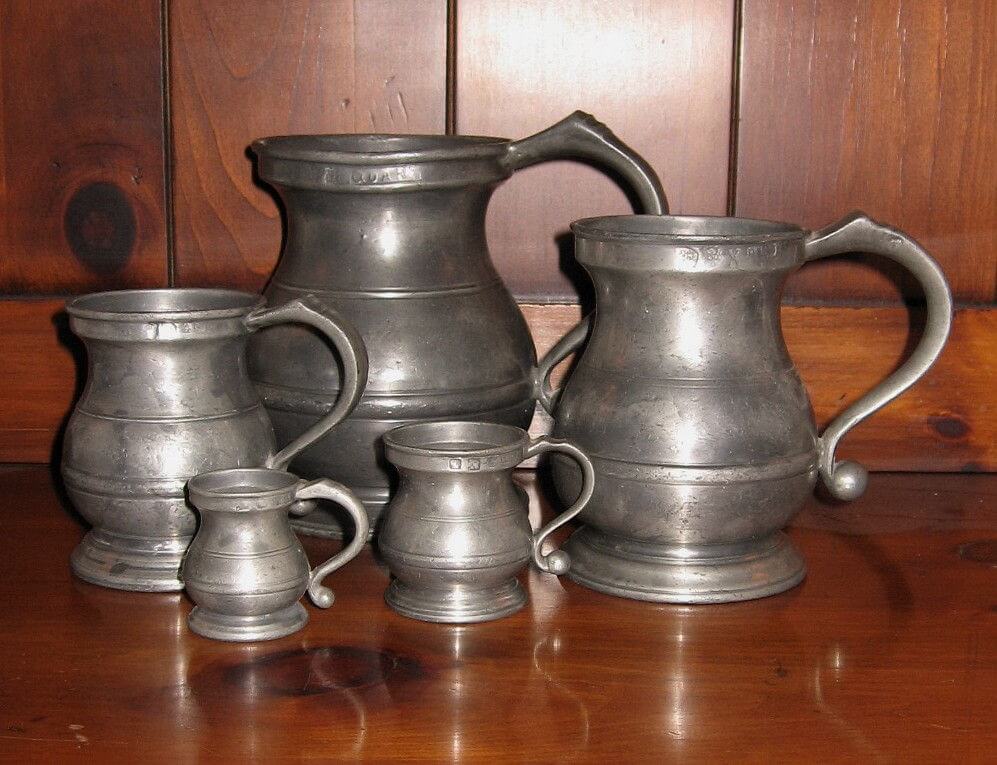When an individual puts in many years becoming an expert in particular field of endeavor, he or she is referred to as a gray eminence, or, more commonly, by the French term “eminence gris.” On the antiques market, if anything can be said to fit that title, it would have to be pewter.
Pewter has been stock-in-trade for antique shops for as long as there have been antique shops. And few materials can more instantly evoke the stately charm of olden days when included in your interior décor.
Pewter has a unique beauty all its own with its own special history. Originally a 50-50 alloy of tin and lead, pewter is now more likely to contain mostly tin, but in a lesser amount, and a greater percentage of an array of other metals, like antimony and bismuth.
By the late 1700s, most of the lead was removed from pewter with the introduction of Britannia, a formula of 92-percent tin with antimony and copper. This made pewter objects safer for drinking and dining.
We can trace pewter back to the Bronze Age, about 2,000-500 BC. There is early evidence of pewter objects in use in China, the Middle East and North Africa.
The word “pewter” is an English word, however, derived from the old English for spelter, (an alloy including zinc). It is this English word that spread throughout Europe (Dutch: peutre; French: piautre; Italian: peltro; Spanish: peltra). The Romans made pewter in England, and eventually English pewter became the standard by which all pewter would be judged.
The English brought their expertise at pewter-making to the colonies, Paul Revere being, perhaps, the most famous of our early pewter smiths. Ever since, Americans have associated pewter with Colonial or Federal décor – a distinctly American look.
Collecting investment quality old pewter can be challenging. For history buffs, however, it can be lots of fun. Marks on pewter, called touch marks, can take a bit of research to sort out. On a single piece there may be a maker’s mark, an excise or tax mark, the mark of the merchant who sold it, and the mark of the owner the piece was made for. English pewter from 1826 to 1878 includes a crown mark along with the initials of the reigning monarch. So a crown and the initials “VR” is during Queen Victoria’s reign. The VR stands for “Victoria Regina.” A website that can help you get started is www.pewtercollectorsclub.org.
There are some 20th Century American and European companies that made fine pewter objects that you may find popping up in antique shops at very reasonable prices. One of these companies is Queens Art Pewter, which two German immigrants, Anton Thuerer and Frederich Bauer, started in their Brooklyn, N.Y. kitchen in 1930. Even though it was the beginning of the Depression, they did so well they were able move their operation to the Brooklyn Navy Yard.
They eventually sold their operation in 1970 to an entrepreneur anxious to capitalize on the demand for pewter that would accompany the celebration of the American Bicentennial in 1976. The company closed its doors in 2000. You can often find fine examples of Queens Art for from $5 to $50.
From Europe, look for a company with the interesting name Les Potstainers Hutois, also called Finstain Pewter from Belgium, a company started in 1949, and which, I believe, is still in business. Finstain pieces may start at about $50 a plate and go up from there to about $300 for some larger pieces.
Commonly collected items in pewter include plates, measures – quart, pint, etc. – in graduated sets, tankards, mugs and spoons. You may also find bowls, including pedestal bowls sometimes called Revere bowls, platters, and candlesticks.
Pewter displays well with any old English style, American Federal and Colonial styles, and both American and European Country styles. Pewter is available, affordable and easy to take care of. Just dust it and occasionally rub it with a clean white colon cloth. Pewter has a dull, dreamy sheen that gives off a soft light, emphasizing its form.
Mark your Calendar. If you would like to have some things appraised and have a good time too, I have two suggestions for you: First, Come to the Teaberry Marketplace on Route 9 in Clermont May 17. I’ll be doing appraisals there between 11 a.m. and 3 p.m. Make it a lunch date; they have a neat café there. Call 624-1700 for more information.
Second, the annual Avalon Antique Memorial Day Weekend Show will be a two-day affair this year, May 23 (12 p.m. – 4 p.m.) and May 24 (9 a.m. – 4 p.m.) at Community Hall on 30th Street and the Boardwalk. And it’s free admission! I’ll be there the second day from 10 a.m. to 2 p.m. doing appraisals.
This event has traditionally been season opener for this area, and it’s always lots of fun. It’s all for a good cause: The Brodesser Cancer center at the hospital. I’ll have more about this in the next column. In the meantime, call Dr. George Zitnay at 463-4040 for more information.
Hope to see you at either or both of these events to answer your questions and appraise your thing.
Arthur Schwerdt, a certified appraiser, is the author of “The Antique Story Book: Finding the Real Value of Old Things,” and co-owner of The August Farmhouse Antiques on Route 9 in Swainton. Send your comments, questions and appraisal requests to aschwerdt@cmcherald.com.
Avalon – Look how Trump has junked up the fireplace in the White House with those fake gold add ones. Just like the Taj Mahal which looked like a brothel. Why does he love that fake gold look?








